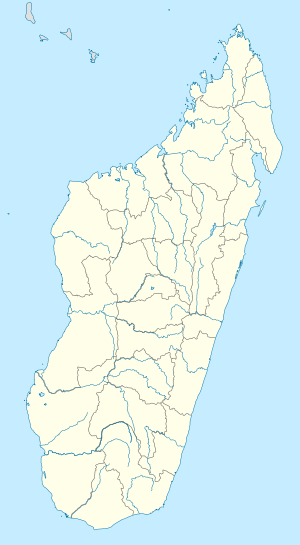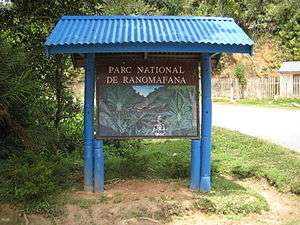Ranomafana National Park
| Ranomafana National Park | |
|---|---|
|
IUCN category II (national park) | |
|
Entrance sign to Ranomafana National Park | |
 Location of Ranomafana National Park in Madagascar | |
| Nearest city | Fianarantsoa |
| Coordinates | 21°13′S 47°25′E / 21.217°S 47.417°ECoordinates: 21°13′S 47°25′E / 21.217°S 47.417°E |
| Area | 416 km² |
| Established | 1991 |
| Governing body | Madagascar National Parks Association |
| Type | Natural |
| Criteria | ix, x |
| Designated | 2007 |
| Reference no. | 1257 |
| State Party | Madagascar |
| Region | List of World Heritage Sites in Africa |

Ranomafana National Park is in the southeastern part of Madagascar in Haute Matsiatra and Vatovavy-Fitovinany. With more than 41,600 hectares (161 square miles) of tropical rainforest, it is home to several rare species of flora and fauna including the golden bamboo lemur, the greater bamboo lemur, black and white ruffed lemur and Milne-Edwards sifaka, and over 130 species of frogs. Pitta like ground rollers, blue vangas, short-legged ground rollers and brown mesites can be seen. The park was established in 1991 with the purpose of conserving the unique biodiversity of the local ecosystem and reducing the human pressures on the protected area. It is part of the World Heritage Site Rainforests of the Atsinanana. Adjacent to the park is the Centre ValBio research station, established in 2003 and managed by Stony Brook University with a focus on biodiversity research, community health and education, environmental arts and reforestation.
Geography
The park is 65 km northeast of Fianarantsoa and 139 km west of Mananjary in the regions of Haute Matsiatra and Vatovavy-Fitovinany.
National Roads nos. 45 and 25 cross the park.[1]
The park office is at the entrance in the village of Ambodiamontana, at 6,5 km from Ranomafana.
Flora and fauna
The park is an important example of cloud forest, with very high levels of biodiversity.
There are a number of lemur species, including:
- Peyrieras' woolly lemur, Avahi peyrierasi
- Aye-aye, Daubentonia madagascariensis
- Crossley's dwarf lemur, Cheirogaleus crossleyi
- Sibree's dwarf lemur, Cheirogaleus sibreei
- Greater bamboo lemur, Prolemur simus
- Golden bamboo lemur, Hapalemur aureus
- Ranomafana grey bamboo lemur, Hapalemur griseus ranomafanensis
- Red-bellied lemur, Eulemur rubriventer
- Red-fronted brown lemur, Eulemur rufifrons
- Small-toothed sportive lemur, Lepilemur microdon.
- Southern black and white ruffed lemur, Varecia variegata editorum
- Red mouse lemur, Microcebus rufus
- Milne-Edwards' sifaka Propithecus edwardsi
Scientific research
The flora and fauna of Ranomafana have been subject to extensive scientific research. Scientific publications have been published.
Lodging
There is a lodge and an ecolodge of a private touristic operator at the entrance of the national park. There are also several hotels in Ranomafana village available for lodging. Additionally, it is possible to camp at the campsite near the main road through the park or to find lodging at Centre Val Bio, where most of the scientific research is based from.
See also
External links
| Wikimedia Commons has media related to Ranomafana National Park. |
| Wikivoyage has a travel guide for Ranomafana National Park. |

